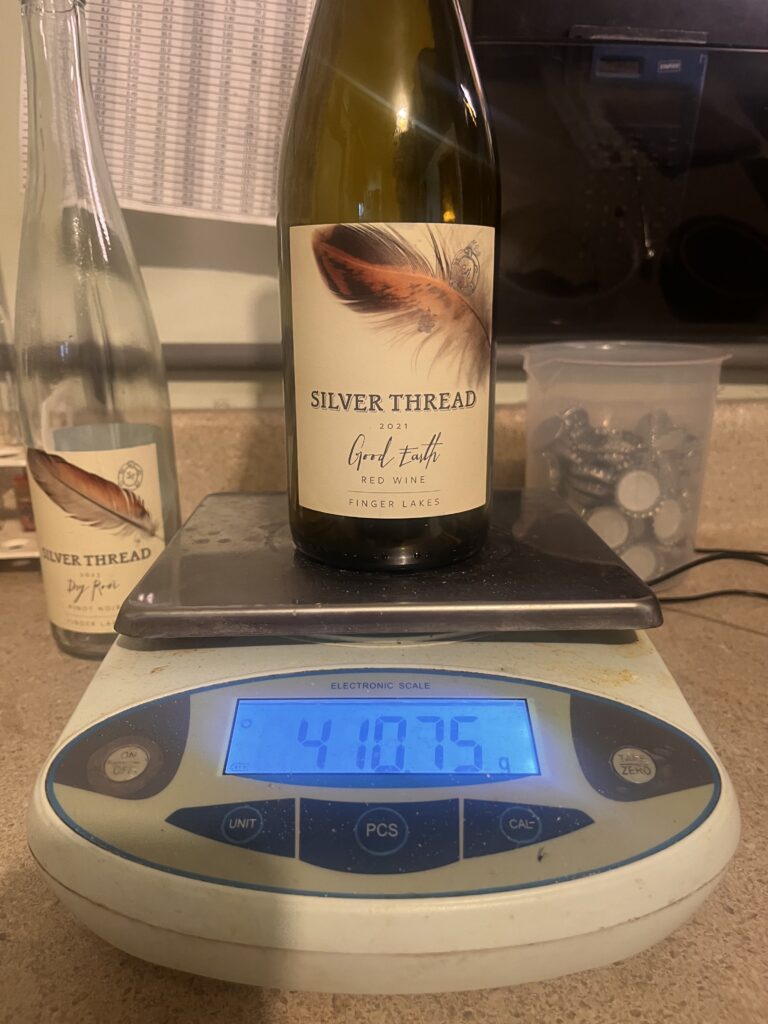Reducing Carbon Footprint through Lightweight Glass
April 26, 2024– What is the best thing an environmentally-conscious wine drinker can do? It’s probably no surprise that number one is to buy from small, local producers. Small producers use fewer inputs in their farming and production, and buying local reduces energy needed for transportation. Number two might be a little bit less intuitive: buy wine packaged in lightweight glass bottles.
The greatest share of wine’s carbon emissions comes from production and transport of the glass bottle it’s packaged in. Studies estimate that glass comprises 30-50% of wine’s carbon footprint. The average glass bottle weighs about one pound (500-600g). The heaviest can be up to two pounds, and are thought by some to convey high quality. Lightweight glass, sometimes called “eco glass” weighs less than 500g.
Several leading wine critics, including Jancis Robinson, Karen MacNeil and David McIntyre, have begun publishing bottle weights on their wine reviews to increase awareness among consumers. Karen McNeil has gone so far as to deny reviewing wines bottled in heavy glass. Jancis Robinson co-authored an on-line petition in 2021 urging wine producers to commit to using lightweight glass. Silver Thread signed that petition, which can be viewed here: Reduce the Wine Industry’s Carbon Emissions.
Our Commitment to Lightweight Glass
Since purchasing Silver Thread in 2011, owner-winemakers Paul and Shannon Brock have always used eco glass. When available, we purchase glass produced in Pennsylvania so that the carbon footprint of transport from the forge to the winery is less. The weight of the bottle has zero impact on the wine’s quality. Lighter glass also reduces direct shipping costs because UPS Ground and FedEx fees are based on weight.
We’ve began publishing the weights of our glass bottles on our web site and winemaker notes. Here are some current bottle weights:
Dry Riesling, Dry Rose of Pinot Noir, Gewurztraminer, Good Earth White, Semi-dry Riesling-450g (all of these are the same shape bottle)
Good Earth Red-411g
Blackbird Red, Cabernet Franc-472g
Petillant Naturel-695g (The average bottle weight for sparkling wine is 800g. Bottles need to be heavier to withstand the pressure inside.)

Why use Glass?
Many are advocating for alternative packaging for wine, such as aluminum cans and plastic or PET bottles. As winemakers, we have concerns about the integrity of the wine in non-glass containers. Both cans and plastic bottles fail to uphold the quality of the wine over time. Although glass requires a lot of energy to produce, it is made from natural materials (sand) and is recyclable.
We are excited about a study taking place at Cornell University to investigate the feasibility of customers returning bottles that can then be washed and reused. Verallia, a French glass producer that we sometimes purchase from, is developing a 300g bottle that will soon be available in the US. We will continue to stay on top of developments in the wine packaging arena so that we can further work to minimize our carbon footprint.
For More Information on this topic:
David McIntyre, “The weight of that wine bottle doesn’t indicate quality, and it’s hurting the planet,” Washington Post, November 4, 2021
David McIntyre, “Lighter Wine Bottles Don’t Affect Quality and are Better for the Planet,” Washington Post, April 13, 2023
Jancis Robinson, MW-“Bottle Manufacturers, Take Note,” Purple Pages, June 8, 2023
John Sumners, “As Major Wine Critic Calls Time on Heavy Bottles, Will Others Follow Suit?”, VinePair, February 26, 2024


